1984 Austrian Grand Prix race report
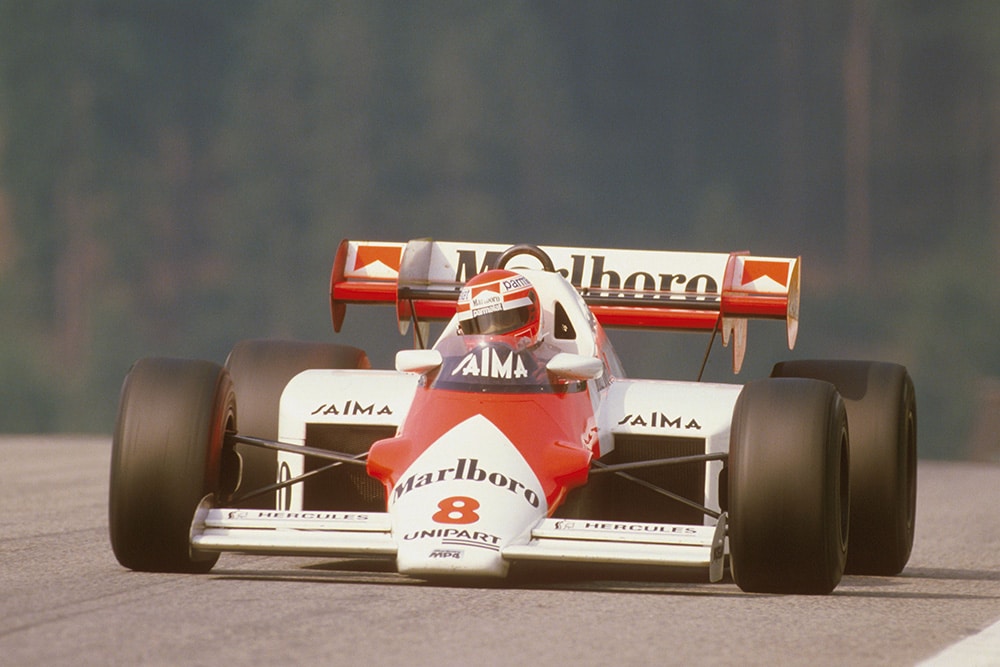
Niki Lauda extended his championship to healthy 4.5 points at the Österreichring
Motorsport Images
— The Lauda touch
Osterreichring, Knittelfeld, August 19th
If you have the opportunity of driving round the Osterreichring in any sort of car you can easily see why any self-respecting racing driver just loves to race on the circuit. It would be hard to make a choice between the Austrian GP circuit and the Spa-Francorchamps circuit in Belgium, either for exhilaration, satisfaction or sheer grandeur and a visit to either circuit would illustrate why I consider Brands Hatch to be a stadium and Silverstone to be an airfield circuit. Not everyone loves the Osterreichring, the “beautiful people” do not invade it as it is not socially recognised, and many team members and professional people do not like it because it needs some motoring effort to get to it, but the spectators love it. You can camp along the edge of the track, the scenery is superb, the cars are going very fast, some of the vantage points are the best in the racing world and there is a splendid holiday atmosphere, which is why the Austrian organisers have named the race The Holiday Grand Prix. But as so often happens, holidays can be spoilt by rain. . . .
When the “circus” began to arrive in Austria the rain was falling steadily and it was still raining on Thursday when the last of the stragglers got to the circuit. However, the heavens looked down kindly on Formula One and on Friday morning the sun shone and everything dried up rapidly. The bad weather had kept the public away on the first day of practice, and car parks and camping grounds that normally fill up on Thursday afternoon and evening were virtually empty, though by Saturday everything was normal and a huge crowd began arriving, numbering over 85,000 for race day. This was brought about by a number of things, among them the successes so far this season of Niki Lauda, the overall high standard of competitiveness in Formula One at the moment, with German, Italian, French and Japanese industry all battling against one another, and finally of the appearance of two young Austrian drivers in the race, as well as the seasoned Lauda. The two newcomers were Jo Gartner, who has settled in after a shaky start at Imola, and Gerhard Berger, fresh from Formula 3, being given a chance in the second ATS, Gartner being in the second Osella as in previous races. With the exception of the injured Martin Brundle and Johnny Cecotto, both of whom are progressing well, everyone was present and things were soon running normally with McLarens, Brabhams, Lotuses and Renaults setting the pace in the first test session.
With a lap speed of over 150 mph and some pretty daunting high-speed corners, the Osterreichring has an important keynote and that is horsepower; but added to this, high-speed handling has to be impeccable and aerodynamics have to be adjusted to give the best road-holding on the fast swerves without causing too much drag on the straights. That horsepower was all-important was soon shown by the speed-trap times of the cars as they crossed the finishing line bythe beginning of the pits. McLaren, Renault, Brabham and Lotus were all posting speeds of over 180 mph, which meant that they were knocking on 190 mph by the end of the pits and at the point where they started the steep climb up to the Hella Licht “chicane”.
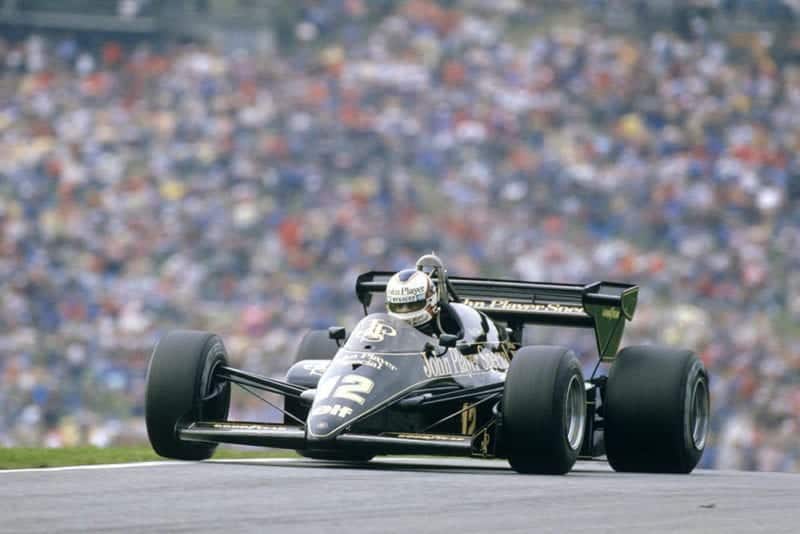
Nigel Mansell qualified 8th for Lotus
Motorsport Images
Considering that they exited the Jochen Rindt Curve at around 140-150 mph and it is only a few hundred yards down to the finishing line you can get some idea of the “grunt” available to the drivers with the more powerful turbocharged 1 1/2-litre engines. The two lonely Cosworth DFV-powered Tyrrells were more than 20 mph slower through the speed trap. There are people who talk lightly of Formula One cars having as much as 1,000 bhp on tap, but realistically a shade over 700 bhp has been known from a works BMW engine, and Formula One cars don’t come any faster than a Brabham BT53 at the moment. Even so, 650-680 bhp from a 1 1/2-litre engine on petrol is pretty staggering, no matter how much boost pressure is being used.
Throughout the two days of morning testing and afternoon qualifying, engines and tyres were all important, and for a change the BMW engines were trouble free, as were the Ferraris most of the time, but Renault and Porsche had their problems and breakages, as did some of the Hart engines, while the Honda engines were never really right and were always just that little bit down on the opposition. Due to Renault engine trouble Tambay soon took to the spare car (RE50/02) and found it much more to his liking, so he stayed with it throughout practice and the race. The Ferrari team had arrived with four cars as usual, but they were a mixture of old and new and the variations available suggested a loss of direction. Arnoux had a brand new car (077), with the latest rear suspension, as seen at Hockenheimring as well as an earlier car (074) also with the new suspension, but with Renault-style air tunnels under the rear suspension in addition. Alboreto had a car with the old rear suspension, and a lengthened gearbox casting to give a slightly longer wheelbase. Some of the 120-degree V6 engines had two-into-one exhaust pipes from each cylinder, while others had two separate pipes from each cylinder. One had the feeling that the Ferrari team were in the wilderness and had lost their way, and by the end of the meeting it looked even more so.
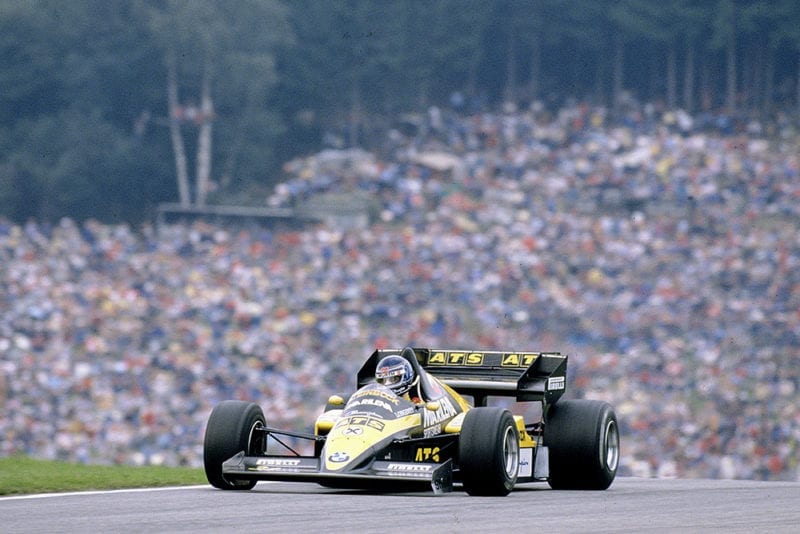
It was a debut grand prix appearance for local hero Gerhard Berger in the ATS
Motorsport Images
Apart from sheer horsepower and torque from the engines, another critical factor was tyres, and of the three tyre companies who are supporting Formula One at the moment, Michelin seem to have the advantage. Goodyear runners were definitely handicapped, and without a Top Team on Pirellis it was difficult to assess their real worth, but at least none of their customers seemed to be suffering.
Qualifying
Friday morning was notable for a number of spins and excursions onto the grass and through the cornfields. Teo Fabi spun at the Rindt Curve and went backwards into the Armco, escaping unhurt, but his Brabham (BT53/5) needed new wheels, suspension members and other ancillaries, though the monocoque was undamaged. Bellof’s engine broke in his Tyrrell and after laying a trail of oil he spun off into the in-field, ending up sharply against a tyre barrier, and de Angelis went harvesting in the spare Lotus (95T/4) right at the end of the morning. His race car (95T/3) had already broken its Renault engine.
In the first qualifying session it was soon obvious that the issue lay between Prost and Lauda with the McLaren MP4/2 cars and Piquet in the “sprint” Brabham (BT53/3). With Fabi’s car being repaired the two Brabham drivers had to share the T-car, so Piquet did his qualifying runs first and then the pedals and steering were re-adjusted to suit the little Italian and Fabi did his runs. Although Piquet was third, behind Prost and Lauda, there did not seem to be much anxiety in the Brabham camp over the fact that Piquet could not have a final go for pole-position in the dying minutes of the qualifying hour. There was an air of “tomorrow will be time enough” about the team, the whole Brabham pit area exuding confidence, both from Gordon Murray about the car, and Paul Roche about the BMW engines. Piquet is always confident.
The fastest lap in last year’s Austrian GP practice was 1 min 29.871 sec, by Tambay in a Ferrari, and already Prost, Lauda and Piquet were into the 1 min 26 sec bracket, Prost’s best time of 1 min 26.203 sec representing an average speed of 154.193 mph. Apart from the Ferraris being desperately slow, for Ferraris, everything was pretty orderly, and it was a change to see Laffite up in the first ten with his Williams-Honda, while once again Ayrton Senna was up near the “big boys” with his Toleman-Hart.
Saturday was clear and cool and the crowds were swelling visibly, with much publicity being given to the possibility of Lauda winning his own Grand Prix, something he had never done. The morning test session went off all right, apart from a few breakages here and there, some of which were repairable and some were not. Berger was unable to take part in the final hour, due to gearbox trouble, but he had qualified well on Friday, and Ghinzani had to miss the final hour due to trouble with the Osellas. To break into the 1 min 26 sec was the objective of the top runners, and de Angelis did this with a splendid 1 min 26.318 sec, which put him third fastest overall, and Tambay got in a 1 min 26.748 sec, still in the Renault T-car, so we now had five drivers in this elite bracket, which represented average speeds of well over 152 mph and the McLarens had pushed the speed-trap times up to 183 mph. Amidst all this high speed at the top end, the bottom of the grid was struggling along at an average of a mere 138 mph. The two Tyrrell-Cosworths were totally outclassed and neither Johansson nor Bellof ever looked like scraping onto the starting grid, there being 28 aspirants for the 26 places.
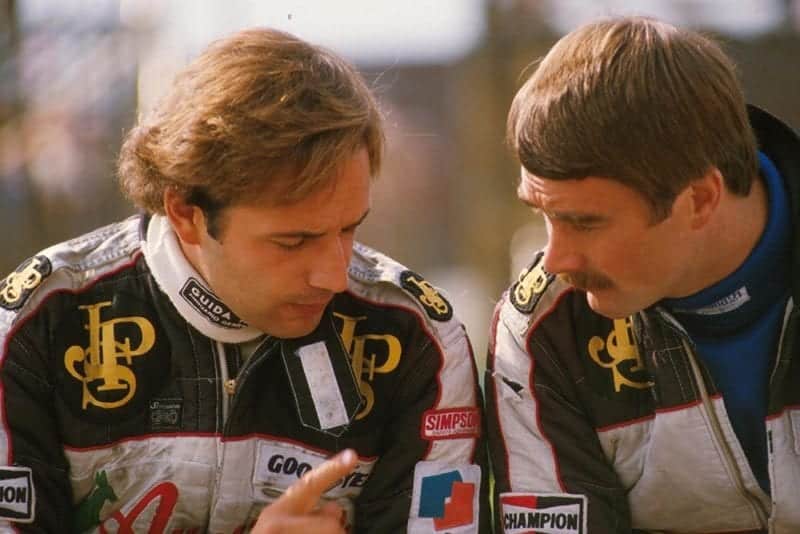
Lotus team mates Elio de Angelis, left, and Nigel Mansell talk Österreich
Motorsport Images
For the first time since the Monaco GP in 1967 there was a starting grid without a Cosworth V8 engine on it. Historic indeed. In addition, it was going to be the first starting grid with a complete entry of turbocharged engines on it, and it is ironical that Ken Tyrrell was the leader of the turbocharged opposition some years ago, who said that turbocharging would not catch on!
As if fate is against Tyrrell and his Cosworth engines, during the final qualifying hour Bellof was out in the spare Tyrrell car when the scrutineering lottery picked on number 4 to be weighed as it came into the pit lane. It came out at 537 kgs, 3 kgs under the legal weight, and no matter how the scales were surveyed the answer kept coming up at 537 kgs, so the Stewards of the Meeting had no option but to exclude number 4 car from the whole meeting, as the rules require. So not only did the last Cosworth powered Formula One cars leave the scene through sheer lack of power, but the last one of all was disqualified for cheating. As if Ken Tyrrell doesn’t have enough problems with officialdom already, without being caught out on a simple thing like the weight during qualifying.
Quite early on in the final hour on Saturday afternoon, Piquet had gone out in the Brabham T-car and posted 1.26.490, which was quicker than his Friday time, and then he went out on his second set of qualifying tyres and did 1.26.173, which snatched pole-position away from Prost and there was nothing the Frenchman could do about it. That confident air in the Brabham pit on Friday afternoon was not illusory.
Race
Sunday morning was a bit heavy and sultry, but fine weather was promised and during the half-hour warm-up period from 10.30 to 11 am there were a few problems, but with the race due to start at 2.30 pm there was time to sort them out. Prost had his Porsche engine blow up, and a new one had to be installed, and Winkelhock broke his ATS gearbox and that had to be changed. For everyone else it was a case of final preparation for the race. In full race-trim lap times were some five seconds slower and the maximum through the pit-straight speed trap was down from 183 mph to a mere 175 mph.
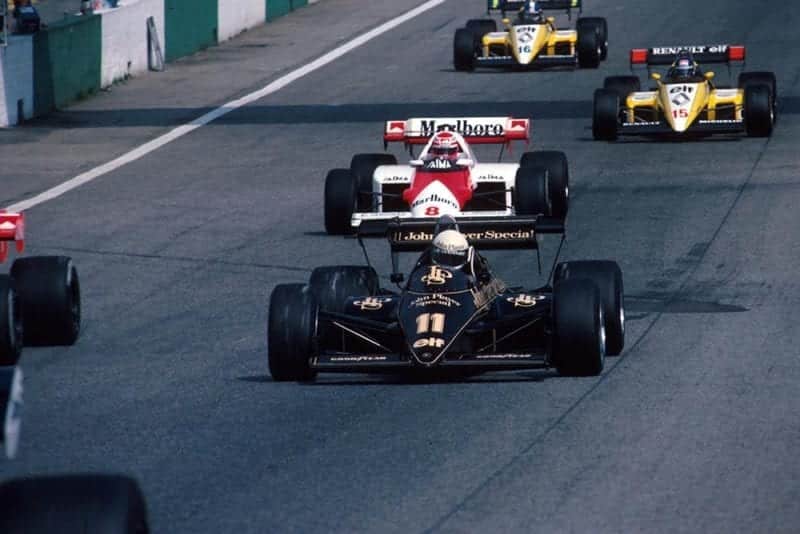
Lotus’ De Angelis in the pack on the first lap
Motorsport Images
Before the competitors left the pit lane to go round to the formation grid, the FISA expected the current leaders in the Drivers World Championship to do a parade for the benefit of the spectators, but every time this has deteriorated into a shambles, with some drivers using the extra lap or two for test purposes, others undecided as to how many laps they are supposed to do, or how fast to go, and all told the whole thing is a joke. The public would probably appreciate the drivers going round slowly, without their protective gear, in the order of the points situation, but that seems to be more than Formula One is capable of organising.
Eventually 25 of the 26 starters left the pit lane and formed up on the grid, the missing car being the ATS-BMW of Winkelhock. Having fitted another gearbox and re-assembled the whole back end the gear-selection did not work and it was too late to start all over again. Piquet led the field round on its parade lap and all 25 cars stopped on the starting grid, the lights flashed and instantly there was a schemozzle in the mid-field as de Angelis failed to get his Lotus into gear and Tambay was blocked behind him. While Fabi and Rosberg jinked round to the side, Laffite came to a stop. The whole start had been unsatisfactory and the starter aborted the start with the orange light, but the first few rows had long gone, racing away up the hill, while the rest trickled off, knowing there was going to be a re-start. On that abortive lap the Dutchman Rothengatter, in the Spirit car, spun off onto the grass and while the cars were regrouped he was towed back and dusted down and put back on the grid. The situation was quite clear, the race was going to be restarted as a new race, and the distance would be reduced from 52 laps to 51 laps. This time all went well and Piquet led away, with Prost, Tambay, Warwick, de Angelis and Lauda in hot pursuit. Things soon settled down into a Michelin race, as de Angelis dropped back, and then it was Piquet and Prost out on their own, followed by Tambay and Lauda. Vying for fifth place were Warwick, Senna and de Angelis, the Lotus driver hanging on valiantly.
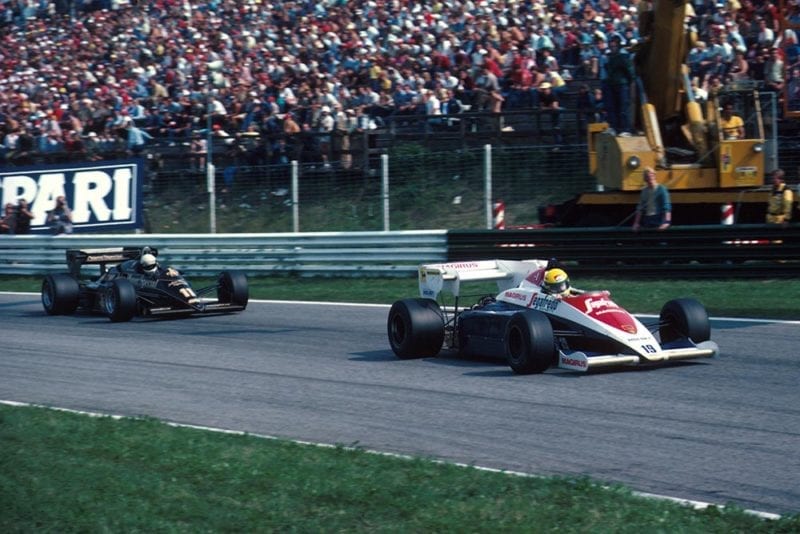
Toleman’s Ayrton Senna’s leads de Angelis
Motorsport Images
By ten laps the Lotus driver had got the better of Senna’s Toleman and Warwick’s Renault and was in a strong fifth place, but a long way back from the leaders, Piquet and Prost being out on their own. Lauda had passed Tambay, which made the Frenchman call at the pits for a new set of Michelins, and it began to be noticeable that the wily Austrian was now matching the speed of the two tearaways who were out in front. As everyone in Formula One racing knows, never underestimate Niki Lauda, and when you realise that the leaders are not getting away from him and he is lying third you have to be prepared for anything. Ayrton Senna was doing a fine job in sixth place, hounding Derek Warwick, and the Hampshire man must have been a bit piqued at seeing a Toleman-Hart in his works Renault mirrors so consistently, having left the Toleman team last year for a place in the Renault team. He stood the pressure for a number of laps and then dived into the pits for new tyres, leaving Senna in fifth place, but two laps later the Renault engine expired and that was the end of Warwick’s race. Already the field was depleted by others, the two Osellas going out early, followed by Laffite whose Honda engine failed, and then Rosberg simply gave up with depression at the way his Williams-Honda was going.
At the moment the Achilles-heel of the dominant McLaren-Porsches seems to be the McLaren gearbox, and the more power and torque that the Weissach Porsche engineers produce the more marginal becomes the gearbox. After only a handful of laps Prost was finding it necessary to hold his car in fourth gear, the two successive starts not helping matters. Piquet was still leading the race, driving on his mirrors and setting his pace by the McLarens, for he could now see Lauda in third spot, but the World Champion is a master at letting the others set the pace, and he looked very comfortable out in front, with the two red and white cars from Woking equally spaced behind him. As he rounded the Rindt Curve at the end of lap 29 there was a trace of oil left by the broken Renault engine in the Lotus of de Angelis, which had trickled into the pits at the end of lap 28, with a merry little oil fire burning away around the back of the car. In a flash the leading Brabham gave a twitch, which Piquet caught instantly, but when the second place McLaren slid on the oil Prost only had one hand on the wheel, his right hand was on the gear lever, and that was his undoing; the McLaren spun and stalled on the outside of the curve without hitting the barriers, but the Frenchman’s race was over.
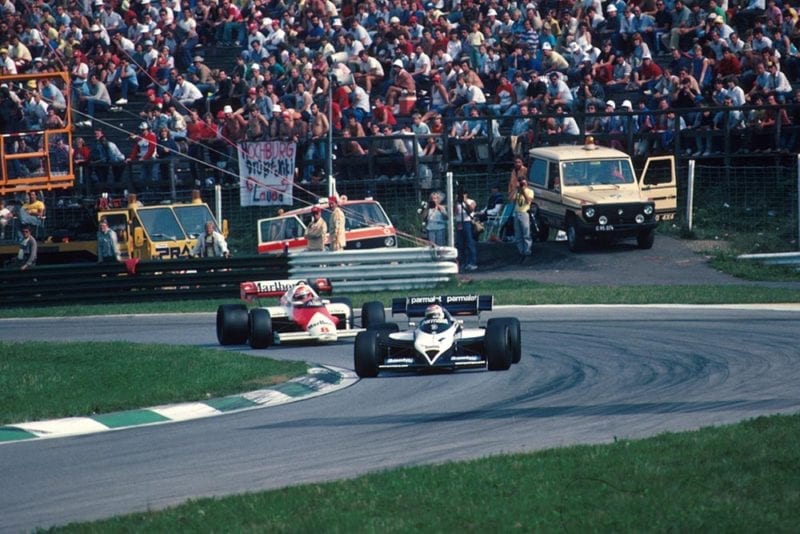
Lauda hunts down the Brabham of Nelson Piquet
Motorsport Images
It wasn’t over for Piquet, however, for no sooner had one red and white car gone from his mirrors than another appeared, as Lauda moved into second place, and of all the people in Formula One the last one you need in your mirrors is the crafty and experienced Lauda. We now had the two best tacticians in racing in first and second places and the gap was closing, which Piquet knew only too well as he looked in his mirrors each time on the run down past the pits. Piquet’s tyres were wearing down, having been stressed during his battle with Prost, whereas the crafty Lauda had preserved his during the opening stages, and he was now in good form. Closer and closer he got to the blue and white Brabham as they came up to lap Alboreto’s Ferrari, and on lap 40 Lauda went by into the lead, to the cheers of his compatriots. Knowing he could not fight back Piquet eased off to make sure of second place, but on lap 41 it was strange that Lauda had not lapped the Ferrari ahead of him, and he seemed to have slowed at the same time as Piquet slowed. It was the McLaren Achilles-heel, the gearbox. As he drove lap 42 Lauda virtually heard a bang from the back of the car as something broke in the gearbox and he lifted off thinking it was all over, but then found that the only thing wrong was that fourth gear was inoperative, though whether any broken bits were about to get tangled up inside he had no idea. With typical Lauda finesse and driving with velvet gloves, he nursed the car along without putting more strain on the gears than was necessary to stay ahead of the Brabham. There was no drama, no gesticulating, in fact no signs that anything was wrong, so that neither Piquet nor his pit staff could guess at anything amiss. It all looked as though Lauda was easing things off to cruise home ahead of the Brabham with its worn rear tyres.
All this time Tambay had been going great guns since his stop for new tyres and had worked his way back into a fine third place, gaining as much as six seconds a lap on Lauda, but it all came to nought when the Renault engine blew up on lap 43, almost within sight of the finish. Lauda had slowed down so much that Jonathan Palmer actually passed him with the RAM-Hart, and everyone thought the wily old bird was coasting home, including Piquet, otherwise he would have dived into the pits for a new set of tyres and gone like hell for the last 10 laps, and might even have caught the ailing McLaren.

Mansell retired on lap 32 with engine failure
Motorsport Images
As Lauda crossed the line after 51 laps to win his first Austrian GP and his 23rd in total, mayhem broke out in his gearbox and as he finished his slowing-down lap and turned into the pit lane the jangling noise could be heard from quite a long way off. Only four cars completed the full distance, Alboreto’s Ferrari in third place, nearly a lap behind, and close behind him was Fabi’s Brabham. The little Italian had stalled at the start and got going long after everyone had gone and then driven a tenacious race right up through the field, profiting every time someone retired. Patrese had struggled along manfully with his rather slow Alfa Romeo, and by keeping on pegging away had inherited fifth place, only to lose it on the penultimate lap when his car ran out of petrol losing him five places.
For a change the backmarkers ran reliably and consistently, and the two Arrows-BMWs finished within inches of one another in a race for the line and fifth place, the advantage just going to Boutsen, with Surer sixth. The two RAM-Harts also ran right through reliably, which made a change for drivers Palmer and Alliot, but Arnoux’s performance in the Ferrari was best forgotten, finishing a lap behind the winner after a stop for new tyres. At least Alboreto salvaged third place, but it was black crepe armbands all round for the many Italians who had come to the Osterreichring.
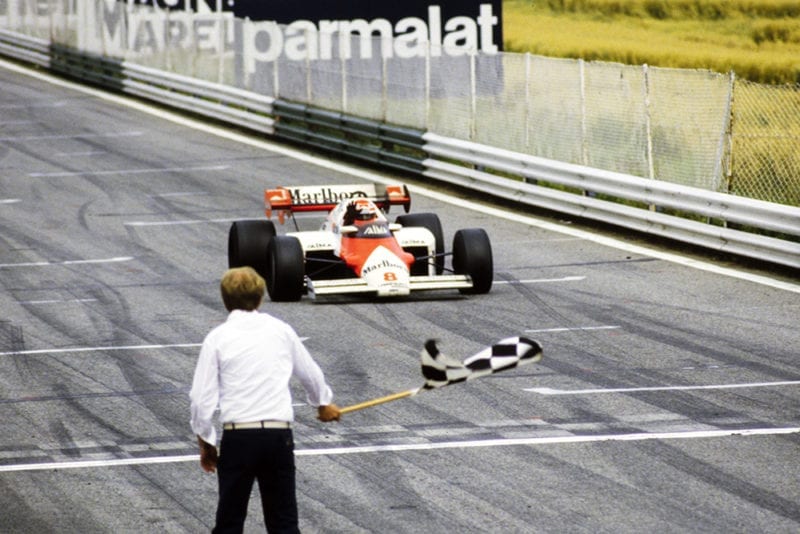
Lauda reaches the finish
Motorsport Images
So intriguing had been the race between the two fastest men in the game (Piquet and Prost) and then the two master tacticians (Piquet and Lauda), that a lot of activity by lesser mortals was overshadowed. Senna’s performance with the Toleman-Hart was first rate, fighting off a strong challenge from Mansell, and then another from Tambay, but eventually the Hart engine lost power and he stopped before it blew up. Both of his challengers were let down by their Renault engines. From the back of the grid the smiling Rothengatter was delayed for a long while in the pits while the Spirit’s exhaust system was repaired, a legacy of his off-track excursion in the brief first race. He eventually returned to the track, far too far behind to have any hope of being classified, but was still running at the finish. A very happy young man was Gerhard Berger, the last to be classified as a finisher, having lost a lot of time with gearbox problems and doing most of the race without the use of second and fourth gears. To finish in his first Grand Prix, and his home Grand Prix at that, was a nice debut. — D. S. J.
